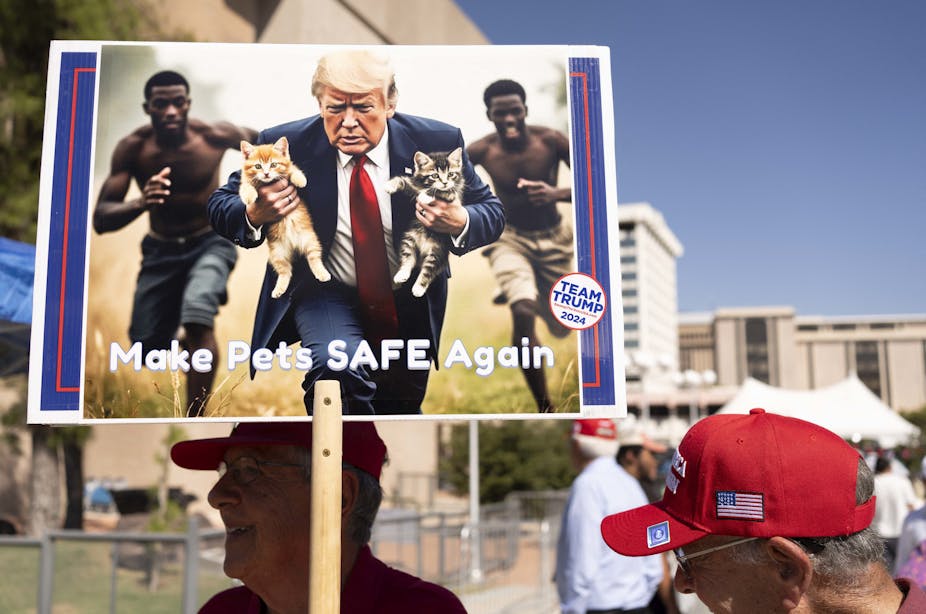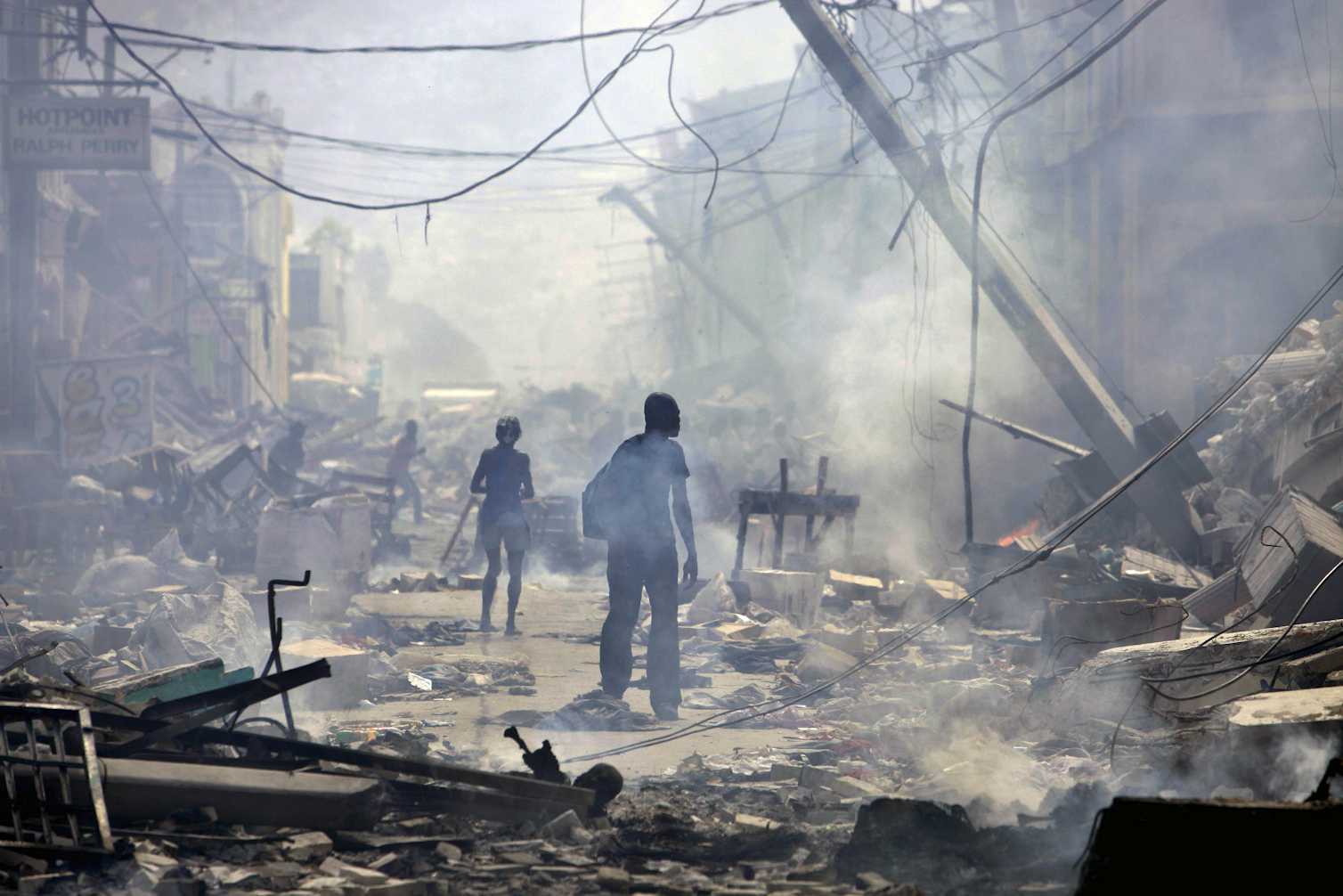
Republican vice presidential candidate JD Vance continues to defend the false claim that migrants in Springfield, Ohio, have been abducting and eating area cats and dogs.
That outlandish idea has been thoroughly debunked since former President Donald Trump repeatedly raised it as an anti-immigrant talking point in the Sept. 12, 2024, presidential debate. Trump never mentioned where the migrants allegedly “eating the pets” came from, but many viewers understood it as a reference to Haitians, a population that Trump has previously degraded.
As debate moderator David Muir stated in his real-time fact check, there is no evidence that any pets in Springfield have been taken or consumed. NPR and other media outlets have also declared the rumor, which began with local right-wing advocates and officials in Springfield decrying the city’s disorganized response to an influx of Haitian migrants in recent years, to be false.
The Republican ticket’s untrue rumors about Haitians in Springfield reflects a long history of prejudice toward Haitians in the United States. As a scholar of Haitian history and literature, I have identified three anti-Haitian ideas prevalent in the United States that will help put the Springfield story into context.
1. The unfitness of Haitians ‘to govern themselves’
In July 1915, U.S. President Woodrow Wilson invaded Haiti under the guise of restoring order and economic stability following the assassination of Haitian President Vilbrun Guillaume Sam.
Five years into what would become a 19-year military occupation, the American diplomat and civil rights leader James Weldon Johnson was sent by the NAACP to investigate the supposed benefits of the occupation. His resounding takeaway: “The United States has failed Haiti.”
In related pieces for The Nation and The Crisis, Johnson chronicled abuses ranging from extra-judicial killings of Haitian citizens – U.S forces killed 15,000 Haitians between 1915 and 1934 – to the harassment and rape of Haitian women. Johnson said the U.S. occupation amounted to nothing more than a belief in the “unfitness of the Haitian people to govern themselves.”
By undermining Haitian sovereignty, Wilson’s administration had successfully created a justification for seizing control of Haitian banks, rewriting its constitution and importing American Jim Crow-style segregation into the capital city of Port-au-Prince. This was a clearly racist presidential administration that hosted White House screenings of D.W. Griffiths’ anti-Black film “Birth of a Nation,” as historian Yveline Alexis demonstrates in her book “Haiti Fights Back: The Life and Legacy of Charlemagne Péralte.”
“Racism,” Alexis writes, “was at the core of the seizure of Haiti and all interactions with Haitians.”
2. The ‘4H disease’
In June 2017, Trump reportedly “stormed into a meeting” on immigration from Haiti and repeated a slanderous anti-Haitian claim: “They all have AIDS,” he said.
The account, from author Jake Johnston, a senior research associate at the Center for Economic and Policy Research, shows the then-president repeating a falsehood that has circulated since HIV erupted in the 1980s.
Ever since a number of Haitians fell ill while at a Florida immigrant detention center in June 1982, Haitians became part of what the late public health expert Paul Farmer called the “geography of blame” that linked this highly communicable disease to certain places and people.
The federal government turned a small disease cluster into a migration policy designed to keep Haitians out of the U.S.
Betweeen 1981 and 1991, more than 27,000 Haitian asylum-seekers fleeing Jean-Claude Duvalier’s dictatorship were intercepted off the coast of Florida and detained. The vast majority were repatriated, in part because of a deportation agreement with Duvalier and in part because stopping Haitians at sea was a “screening strategy” to prevent HIV/AIDS from spreading in the U.S.
The Reagan administration called the virus the “4H disease,” referring to Haitians, hemophiliacs, homosexuals and heroin users. This designation spread harmful lies about four groups, but Haitians were the only nationality singled out as an “at-risk” population for contracting HIV/AIDS.
By the time the Centers for Disease Control and Prevention removed Haitians from its list of highest-risk groups in 1985, the damage had been done. Haitians in the U.S. were effectively vilified as vectors of a deadly virus.
As a young Haitian man in Port-au-Prince remarked to writer Martha Cooley in 1983, “This 4H thing is just one more way to keep us out.”
3. Haiti’s problems are homegrown
Haiti’s occupation by foreign forces has continued on and off in different forms since the U.S. invasion of 1915.
United Nations troops were stationed there for nearly two decades following the the 2004 ouster of President Jean Bertrand Aristide. After the devastating 2010 earthquake, they were joined by the Red Cross and Oxfam. As all three organizations have since acknowledged, their humanitarian interventions left numerous crises in their wake, including cholera, chronic corruption in rebuilding projects and a market for sexually exploiting young girls.

Still, Haiti has long faced the accusation that its instability is homegrown. It is widely portrayed in the U.S. as a basket-case nation incapable of managing its own affairs. Trump, as president, once dismissed the entire country as a “shithole.”
At present, Haitians are coping with overlapping crises that have U.S. fingerprints.
After President Jovenel Moïse was assassinated in July 2021, the Biden administration hand-picked Haiti’s interim prime minister, Ariel Henry, as its new leader. This undemocratic decision was such a resounding failure that in March 2024, Haitian gangs revolted against Henry’s administration, unleashing a wave of gruesome violence that ultimately forced Henry out of office.
So many catastrophes in Haiti over the past four decades have created an overwhelming sense of insecurity among its people. Many hundreds of thousands have fled the country for the U.S., Dominican Republic, Brazil and beyond.
In July 2024, the Biden administration granted temporary protected status to 500,000 Haitian migrants in the U.S., allowing them to stay in the country, in recognition of the life-threatening conditions back home.
The people Trump insists are “illegal aliens” are in fact authorized U.S. residents from a country buffeted by American meddling in its politics.
A very old pattern
In barking about cats and dogs in Springfield, Trump, Vance and their right-wing supporters are spreading the same kind of anti-Haitian rhetoric that has sown a harmful distrust of Haitian migrants for over a century.
“This is not the first time that we [Haitians] have been the victims of ‘yon kanpay manti,’” said the Ministry of Haitians Living Abroad in a press release following the debate, using the Haitian Creole phrase for “a campaign of lies.”
The result of such misinformation, it added, is “mistreatment, hatred, and misunderstanding in the interest of politics.”![]()
Nathan H. Dize, Assistant Professor of French, Arts & Sciences at Washington University in St. Louis
This article is republished from The Conversation under a Creative Commons license.

